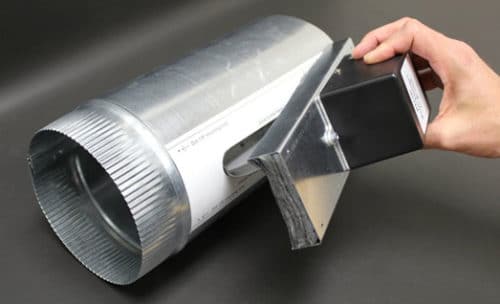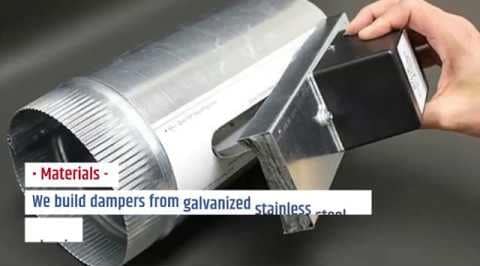HVAC Damper

Businesses and homeowners constantly strive to get the most cost-effective performance from their HVAC systems. Many do so by maintaining control over the distribution of warm or cool air through the installation of HVAC dampers, which oversee airflow throughout your system.
An HVAC damper is a valve or plate that performs a function similar to that of a traffic cop in a major intersection. These components control the amount of heated or cooled air that passes through the HVAC’s ducts toward the system’s distribution network. HVAC dampers act in tandem with the thermostat to deliver the desired air quality—thermostats control the temperature of the air, and dampers control the amount of air that flows through the system.
Dampers allow for more precise control over zone heating and cooling. Using these components results in major cost savings for the operator, because the responsibility for heating or cooling a room relies on more than just a thermostat.
HVAC dampers also allow operators to either limit or completely shut off airflow to unused zones or zones that require a lower volume of heated or cooled air. This permits your central HVAC system to provide temperate air for rooms in use without wasting it on empty areas, resulting in increased energy and cost savings.
Manual Dampers vs. Automatic Dampers
There are two common types of HVAC dampers: manual and automatic. Each system brings unique benefits to HVAC applications.
Manual Dampers
Levers located outside of air vents and ducts control damper plates or valves in a manual system. Most manual dampers have a straightforward design that allows operators to intuitively control airflow through the system, and they tend to be relatively durable and maintenance free.
However, manual dampers lack the precision of automatic dampers. They also cannot be operated remotely, which especially creates difficulties in facilities that mount their HVAC systems on or near their ceilings.
Automatic Dampers
Automatic dampers use small motors to open and close damping plates and valves. The main difference between automatic and manual dampers (including manual motorized dampers) is that automatic systems can be controlled remotely and can self-regulate in response to changing climate conditions.
Operators use thermostats to designate the desired conditions in each of the various zones, and the thermostats then calculate the precise air temperature and airflow that can achieve these conditions. This means that automatic dampers can provide much more precise internal climate conditions than manual dampers, and they can be programmed remotely to doing so.
Diagnosing Damper Issues
Zone dampers tend to be pretty reliable when it comes to monitoring airflow in your systems. However, there are occasions when zone dampers malfunction and create heating or cooling issues.
A number of factors can cause damper issues, but fortunately, systems tend to malfunction in fairly predictable ways, which makes problems easy to diagnose.
Here are some tips for evaluating the health of your manual and automatic damper equipment:
- Check the register’s airflow while the system is running. Evaluating any fluctuations in airflow along the duct line will give you a sense of where the malfunction is occurring
- For manual dampers, close a specific damper using the damper handle. While air continues to flow through the rest of the system, check the registers associated with that particular damper to determine whether airflow has ceased. Then, reopen the damper and check the registers again. If you feel airflow when the damper is closed or no airflow when the damper is open, then you have a damaged damper.
- Troubleshooting automatic dampers involve a different process. Turn on the system and adjust the zone thermostats to a level that will guarantee airflow. Check for airflow in the associated zone registers. If you feel low airflow but the room does not maintain its temperature, or if there is plenty of airflows and the room is drafty, then you could have a faulty HVAC damper.
By and large, malfunctioning dampers are among the least costly issues you will run into in central heating and air conditioning systems. Eliminating this problem is the first step in troubleshooting HVAC systems.
Alan Manufacturing’s Duct Dampers
At Alan Manufacturing, we focus on building high-quality duct dampers for a variety of applications. We provide many types of manual, automatic, and customized dampers to fit the specialized needs of our clients, and we also manufacture components for entire zone control systems.
Manual Dampers
Alan Manufacturing produces a broad range of manual dampers for various installations and for OEM replacement. Among the manual dampers we produce are:
- Volume dampers: We build a variety of gasketed and nongasketed volume dampers, and collared dampers.
- Cable-controlled volume dampers: Alan provides damper controls, which use rotary-to-linear (rack and pinion) mechanical actuator-assembly damper systems for precise and dependable calibration.
- Barometric bypass dampers: These dampers prevent damage to duct systems by bypassing duct static pressure when ducts open and close.
- Manual damper tube assemblies: We offer a dozen different standard damper tube assembly configurations.
Automatic Dampers
We also build a wide variety of automatic dampers and automatic damper systems to meet the needs of our clients, including:
- Motorized round-tube and collar dampers: We offer a variety of tube and rectangular collar dampers for new installations or to retrofit old ones.
- Modulating damper systems: We build damper systems that use thermostats for airflow zone control.
- Wired zone-control systems: These systems automatically adjust heating or cooling to areas that need greater or lesser airflow.
- Wireless zone-control systems: We build these systems to retrofit manual dampers with motorized remote-control systems.
Custom HVAC Damper Capabilities
Whether manual or automated, our zone-control systems serve a broad range of applications across many industries. In addition to manufacturing standard systems, we also provide customized HVAC zone-control systems. Some of our capabilities include:
- Materials: We build dampers from galvanized stainless steel, aluminum, plastics, and other UL-approved materials.
- Damper types: We can build round-tube or collar-tube, rectangular, blade, shutter, or radial dampers per your specifications.
- Control methods: Dampers can be customized with manual, wired zone control, or wireless zone control capabilities.
- Production volumes: We can achieve low- and high-volume production runs as well as product prototyping.
- Lead times: We quote lead times on a job-by-job basis, but most projects typically require 10 days (we also do emergency and rush-order runs as needed).
Our fully furnished facility is capable of a broad range of additional manufacturing capabilities, such as:
- Accessories
- OEM replacement parts
- Assembly
- Punching
- Riveting
- Tooling
- Packaging
- Barcoding
We also have design engineering services available, making Alan Manufacturing a one-stop solution for the HVAC damper and zone-control needs of our clients.
Industry Standards
We emphasize quality assurance and industrial compliance in everything that we do. Alan Manufacturing assembles all equipment to the following standards:
- American Society for Testing and Materials (ATSM)
- CE certification (a mandatory requirement for products in the European Economic Area)
- Restriction of Hazardous Substances (RoHS) code
- UL certification
Boost Your Savings with Alan Manufacturing
Controlling the airflow to your structure’s different zones will reduce costs and improve your environmental efficiency. No component is as essential to this as HVAC dampers.
Alan Manufacturing provides both manual and automatic damper and zone-control systems to improve airflow control. We build both standard and customized systems to meet the needs of our clients.

